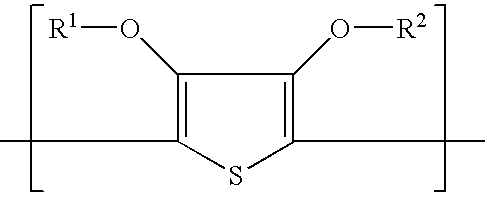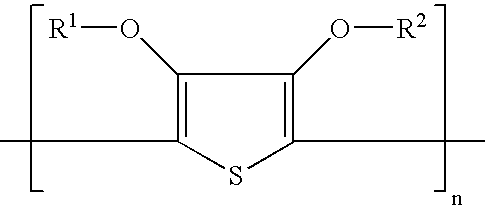Composition containing a polymer or copolymer of a 3,4-dialkoxythiophene and non-aqueous solvent
a technology of dimethyl thiophene and polymer, which is applied in the direction of non-metal conductors, instruments, conductors, etc., can solve the problems of inability to readily disperse, easy to cause lumps and flakes of pedot/pss, and disadvantages of layer transparency for layers with a given surface resistance. , to achieve the effect of enhancing transparency, enhancing transparency, and enhancing transparency
- Summary
- Abstract
- Description
- Claims
- Application Information
AI Technical Summary
Benefits of technology
Problems solved by technology
Method used
Image
Examples
invention examples 16 and 17
[0191]The compositions of INVENTION EXAMPLES 16 and 17 were prepared by adding 400 g of diethylene glycol (DEG) to 400 g of a 1.2% by weight dispersion of PEDOT / PSS with a weight ratio of PEDOT to PSS of 1:2.4 in water and then evaporating the resulting mixtures in a rotary evaporator at 60° C. and a vacuum of 50 mbar giving the composition in Table 3.
[0192]
TABLE 3INVENTIONINVENTIONEXAMPLE 16EXAMPLE 17wt % PEDOT0.3150.307wt % PEDOT / PSS1.071.045wt. % DEG87.9383.955wt % deionized water11.0015.00
[0193]The viscosities at 20° C. of compositions of INVENTION EXAMPLE 13 and a 1.2 wt. % dispersion of PEDOT / PSS in water were measured with increasing shear rate and the results are given for particular shear rates in Table 4.
[0194]This composition can be used directly for coating or different ingredients may be added to produce non-aqueous solvent containing printing inks and pastes for different printing techniques.
[0195]
TABLE 4Shearviscosity [Pa · s]rate1.2 wt. % dispersion ofComposition of ...
invention examples 18 to 22
[0199]The compositions of INVENTION EXAMPLES 18 to 22 were prepared by adding 400 g of 1,2-propandiol, optionally 49 g diethylene glycol and 400 g of a 1.2% by weight dispersion of PEDOT / PSS with a weight ratio of PEDOT to PSS of 1:2.4 in water and evaporating the resulting mixture in a rotary evaporator at 60° C. under a vacuum of 50 mbar giving the composition and subsequently adding CARBOPOL® ETD 2623 or 3-glycidoxypropyltrimethoxysilane to give the compositions given in Table 6.
[0200]
TABLE 6Composition of InventionExample [% by weight]IngredientNr 18nr 19nr 20nr 21nr 22PEDOT0.3000.2790.3180.2790.300PEDOT / PSS1.020.951.080.951.02DEG—11.0—11.0—PD84.0878.2589.4278.2584.083-glycidoxypropyl-————3.00trimethoxysilaneCARBOPOL ®——0.400.40—ETD 2623deionized water14.909.809.109.4011.90
[0201]The compositions of INVENTION EXAMPLES 18 to 22 were screen printed on an AUTOSTAT™ CT7 support using a screen printer with a P120 screen and dried at 120° C. for 120 s.
Characterization of...
invention examples 23 to 34
[0208]The composition of INVENTION EXAMPLE 23 was prepared as described for INVENTION EXAMPLES 16 and 17 and consisted of: 0.75% by weight of PEDOT / PSS, 93% by weight of 1,2-propandiol, 5.9% by weight of water and 0.5% by weight of 3-glycidoxypropyltrimethoxysilane.
[0209]The compositions of INVENTION EXAMPLES 24 to 34 were prepared by adding different surfactants in different concentrations, as given in Table 8, to the composition of INVENTION EXAMPLE 23.
[0210]The compositions of INVENTION EXAMPLES 23 to 34 were screen printed on an AUTOSTAT™ CT7 support, the standard layer of LUXPRIN™ 7153E and the standard layer of LUXPRINT™ 7138J through a P120 screen and dried at 120° C. for 120 s.
Evaluation of the Prints
[0211]The optical density and surface resistance of the prints on AUTOSTAT® CT7 were evaluated as described for INVENTION EXAMPLES 1 to 14. The results obtained with prints prepared with the compositions of INVENTION EXAMLES 23 to 34 are given in Table 8.
[0212]The adhesion of th...
PUM
| Property | Measurement | Unit |
|---|---|---|
| solids content | aaaaa | aaaaa |
| solids content | aaaaa | aaaaa |
| water content | aaaaa | aaaaa |
Abstract
Description
Claims
Application Information
 Login to View More
Login to View More - R&D
- Intellectual Property
- Life Sciences
- Materials
- Tech Scout
- Unparalleled Data Quality
- Higher Quality Content
- 60% Fewer Hallucinations
Browse by: Latest US Patents, China's latest patents, Technical Efficacy Thesaurus, Application Domain, Technology Topic, Popular Technical Reports.
© 2025 PatSnap. All rights reserved.Legal|Privacy policy|Modern Slavery Act Transparency Statement|Sitemap|About US| Contact US: help@patsnap.com



